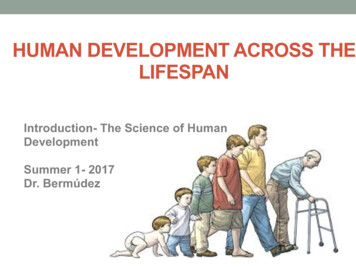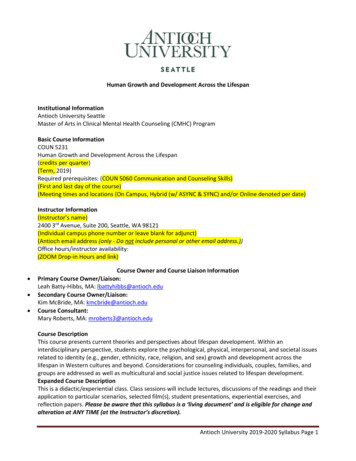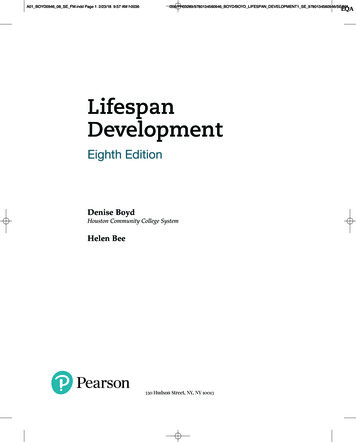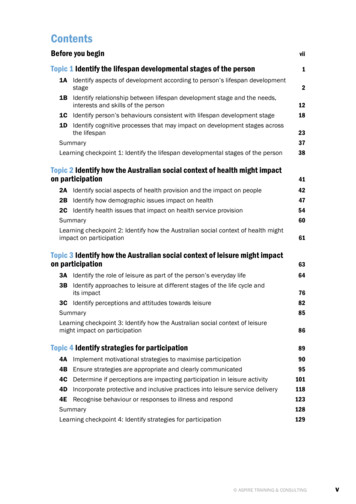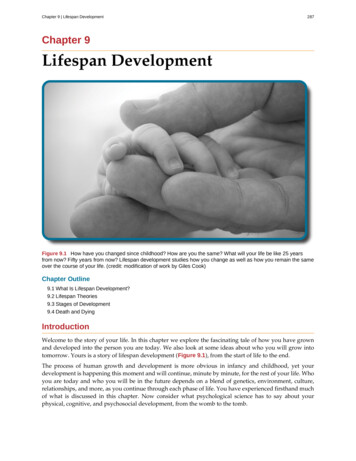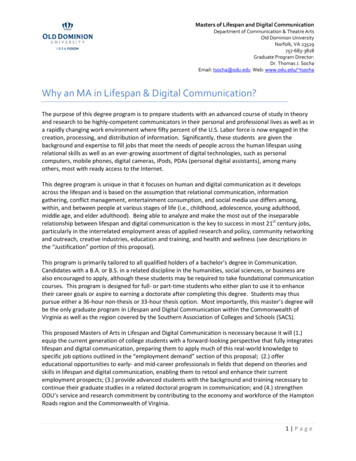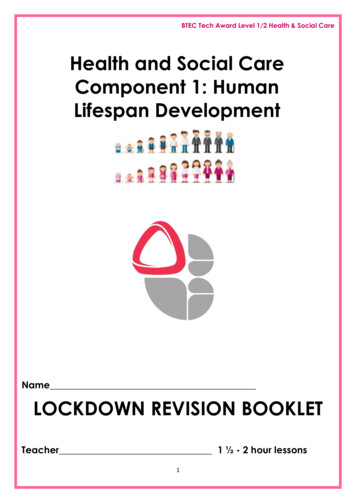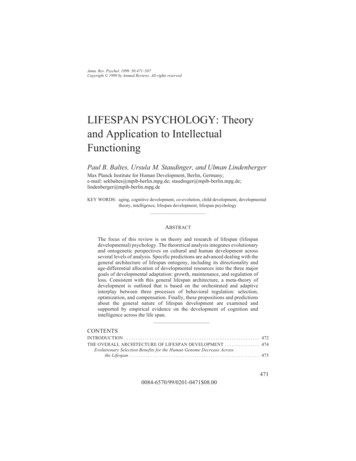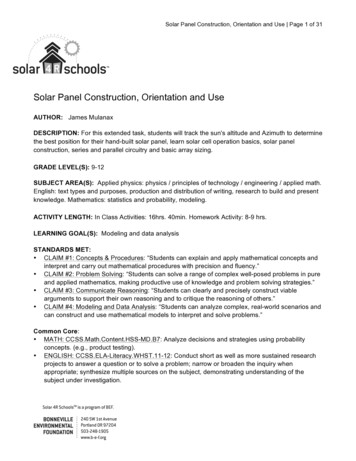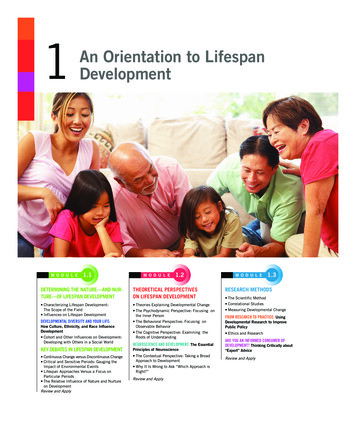
Transcription
1M oduleAn Orientation to LifespanDevelopment1.1M odule1.2Determining the Nature—and Nurture—of Lifespan DevelopmentTheoretical Perspectiveson Lifespan Development Characterizing Lifespan Development:The Scope of the Field Influences on Lifespan Development Theories Explaining Developmental Change The Psychodynamic Perspective: Focusing onthe Inner Person The Behavioral Perspective: Focusing onObservable Behavior The Cognitive Perspective: Examining theRoots of UnderstandingDevelopmental Diversity AND YOUR LIFE:How Culture, Ethnicity, and Race InfluenceDevelopment Cohort and Other Influences on Development:Developing with Others in a Social WorldNeuroscience and Development: The EssentialKey Debates in Lifespan DevelopmentPrinciples of Neuroscience Continuous Change versus Discontinuous Change Critical and Sensitive Periods: Gauging theImpact of Environmental Events Lifespan Approaches Versus a Focus onParticular Periods The Relative Influence of Nature and Nurtureon DevelopmentReview and Apply The Contextual Perspective: Taking a BroadApproach to Development Why It Is Wrong to Ask “Which Approach isRight?”M01 FELD1031 02 SE C01.indd 2M odule1.3Research Methods The Scientific Method Correlational Studies Measuring Developmental ChangeFrom Research to Practice: UsingDevelopmental Research to ImprovePublic Policy Ethics and ResearchARE yOU AN INFORMED CONsUMER OFDEvELOPMENT? Thinking Critically about“Expert” AdviceReview and ApplyReview and Apply08/02/13 9:06 AM
Learning ObjectivesPrologue: New ConceptionsWhat if for your entire life, the image that others held of you was colored by the wayin which you were conceived?In some ways, that’s what it has been like for Louise Brown, who was the world’sModule 1.1LO1 What is lifespan development?LO2 What are some of the basicinfluences on human development?Module 1.2first “test tube baby,” born by in vitro fertilization (IVF), a procedure in which fertiliza-LO3 What are the key issues in thetion of a mother’s egg by a father’s sperm takes place outside the mother’s body.field of development?Louise was a preschooler when her parents told her about how she was conceived, and throughout her childhood she was bombarded with questions. It becameroutine to explain to her classmates that she in fact was not born in a laboratory.As a child, Louise sometimes felt completely alone. “I thought it was somethingpeculiar to me,” she recalled. But as she grew older, her isolation declined as moreand more children were born in the same manner.In fact, today Louise isLO4 Which theoretical perspectiveshave guided lifespan development?LO5 What role do theories andhypotheses play in the study ofdevelopment?Module 1.3LO6 How are developmental researchstudies conducted?hardly isolated. More than5 million babies have beenLO7 What are some of the ethicalissues regarding psychological research?born using the procedure,which has become almostroutine. And at the age of28, Louise became a mother herself, giving birth to ababy boy named Cameron— conceived, by the way, in theold-fashioned way (Falco,2012; ICMART, 2012).Louise Brown and son.Looking AheadLouise Brown’s conception may have been novel, but her development since thenhas followed a predictable pattern. While the specifics of our development vary, thebroad strokes set in motion in that test tube 28 years ago are remarkably similar forall of us. Serena Williams, Bill Gates, the Queen of England, you, and me—all of usare traversing the territory known as lifespan development.In vitro fertilization is just one of the brave new worlds of recent days. Issues thataffect human development range from cloning to poverty to the prevention of AIDS.Underlying these are even more fundamental issues: How do we develop physically?How does our understanding of the world change throughout our lives? And how doour personalities and social relationships develop as we move through the lifespan?3M01 FELD1031 02 SE C01.indd 308/02/13 9:06 AM
4 C hapter 1 An Orientation to Lifespan DevelopmentThese questions and many others are central to lifespan development. The field encompasses a broad span of time and a wide range of topics. Think about the range of interests thatdifferent specialists might focus on when considering Louise Brown: Lifespan development researchers who investigate behavior at the biological level mightask if Louise’s functioning before birth was affected by her conception outside the womb. Specialists in lifespan development who study genetics might examine how the geneticendowment from Louise’s parents affects her later behavior. Lifespan development specialists who investigate thinking processes might examinehow Louise’s understanding of the circumstances of her conception changed as she grewolder. Other researchers in lifespan development, who focus on physical growth, might considerwhether her growth rate differed from that of children conceived more traditionally. Lifespan development experts who specialize in the social world and social relationshipsmight look at the ways that Louise interacted with others and the kinds of friendships shedeveloped.Although their interests take many forms, these specialists share one concern: understanding the growth and change that occur during life. Taking many different approaches,developmentalists study how both our biological inheritance from our parents and the environment in which we live jointly affect our future behavior, personality, and potential ashuman beings.Whether they focus on heredity or environment, all developmental specialists acknowledge that neither one alone can account for the full range of human development.Instead, we must look at the interaction of heredity and environment, attempting to grasp howboth underlie human behavior.In this module, we orient ourselves to the field of lifespan development. We begin witha discussion of the scope of the discipline, illustrating the wide array of topics it covers andthe full range of ages it examines. We also survey the key issues and controversies of thefield and consider the broad perspectives that developmentalists take. Finally, we discuss theways developmentalists use research to ask and answer questions. Many of the questionsthat developmentalists ask are, in essence, the scientist’s version of the questions that parentsask about their children and themselves: how the genetic legacy of parents plays out in theirchildren; how children learn; why they make the choices they make; whether personalitycharacteristics are inherited and whether they change or are stable over time; how a stimulating environment affects development; and many others. To pursue their answers, of course,developmentalists use the highly structured, formal scientific method, while parents mostlyuse the informal strategy of waiting, observing, engaging, and loving their kids.M odule1.1Determining the Nature—and Nurture—of Lifespan DevelopmentLO 1-1 What is lifespan development?LO 1-2 What are some of the basic influences on human development?Have you ever wondered at the way an infant tightly grips your finger with tiny, perfectlyformed hands? Or marveled at how a preschooler methodically draws a picture? Or atthe way an adolescent can make involved decisions about whom to invite to a party or theethics of downloading music files? Or the way a middle-aged politician can deliver a long, flawless speech from memory? Or what makes a grandfather at 80 so similar to the father hewas at 40?M01 FELD1031 02 SE C01.indd 408/02/13 9:06 AM
Chapter 1 An Orientation to Lifespan Development 5If you’ve ever wondered about such things, you are asking the kinds of questions thats cientists in the field of lifespan development pose. Lifespan development is the field ofstudy that examines patterns of growth, change, and stability in behavior that occur throughout the lifespan.In its study of growth, change, and stability, lifespan development takes a scientific approach. Like members of other scientific disciplines, researchers in lifespan developmenttest their assumptions by applying scientific methods. They develop theories about development and use methodical, scientific techniques to validate the accuracy of their assumptionssystematically.Lifespan development focuses on human development. Although there are developmentalists who study nonhuman species, the vast majority study people. Some seek to understanduniversal principles of development, while others focus on how cultural, racial, and ethnicdifferences affect development. Still others aim to understand the traits and characteristicsthat differentiate one person from another. Regardless of approach, however, all developmentalists view development as a continuing process throughout the lifespan.As developmental specialists focus on change during the lifespan, they also considerstability. They ask in which areas, and in what periods, people show change and growth, andwhen and how their behavior reveals consistency and continuity with prior behavior.Finally, developmentalists assume that the process of development persists from the moment of conception to the day of death, with people changing in some ways right up to theend of their lives and in other ways exhibiting remarkable stability. They believe that no single period governs all development, but instead that people maintain the capacity for substantial growth and change throughout their lives.Characterizing Lifespan Development:The Scope of the FieldClearly, the definition of lifespan development is broad and the scope of the field extensive.Typically, lifespan development specialists cover several diverse areas, choosing to specializein both a topical area and an age range.Topical Areas in Lifespan Development. Some developmentalists focus on physicaldevelopment, examining the ways in which the body’s makeup—the brain, nervous system,muscles, and senses, and the need for food, drink, and sleep—helps determine behavior. Forexample, one specialist in physical development might examine the effects of malnutritionon the pace of growth in children, while another might look at how athletes’ physical performance declines during adulthood (Fell & Williams, 2008).Other developmental specialists examine cognitive development, seeking to understandhow growth and change in intellectual capabilities influence a person’s behavior. Cognitive d evelopmentalists examine learning, memory, problem-solving, and intelligence. For example, specialists in cognitive development might want to see how problem-solving skillschange over the course of life, or if cultural differences exist in the way people e xplaintheir academic successes and failures, or how traumatic events experienced early in life are remembered later in life (Alibali, Phillips, & Fischer, 2009; Dumka et al., 2009; Penidoet al., 2012).Finally, some developmental specialists focus on personality and social development.Personality development is the study of stability and change in the characteristics thatdifferentiate one person from another over the lifespan. Social development is the wayin which individuals’ interactions and relationships with others grow, change, and remain stable over the course of life. A developmentalist interested in personality developmentmight ask whether there are stable, enduring personality traits throughout the lifespan,while a specialist in social development might examine the effects of racism or povertyor divorce on development (Evans, Boxhill, & Pinkava, 2008; Lansford, 2009). Thesefour major topic areas—physical, cognitive, social, and personality development—are summarized in Table 1.1. on page 6.M01 FELD1031 02 SE C01.indd 5lifespan development the field of studythat examines patterns of growth, change, andstability in behavior that occur throughout theentire life spanphysical development development involvingthe body’s physical makeup, including thebrain, nervous system, muscles, and senses,and the need for food, drink, and sleepcognitive development developmenti nvolving the ways that growth and change inintellectual capabilities influence a person’sbehaviorpersonality development developmentinvolving the ways that the enduring characteristics that differentiate one person fromanother change over the life spansocial development the way in which individuals’ interactions with others and theirsocial relationships grow, change, and remainstable over the course of life08/02/13 9:06 AM
6 C hapter 1 An Orientation to Lifespan DevelopmentTable 1.1 Approaches to Lifespan DevelopmentOrientationDefining CharacteristicsExamples of Question Asked*Physical developmentEmphasizes how brain, nervoussystem, muscles, sensorycapabilities, needs for food, drink,and sleep affect behavior What determines the sex of a child? (2)What are the long-term results of premature birth? (2)What are the benefits of breast milk? (4)What are the consequences of early or late sexual maturation? (3)What leads to obesity in adulthood? (4)How do adults cope with stress? (4)What are the outward and internal signs of aging? (3)What is the relationship between aging and illness? (4)Cognitive developmentEmphasizes intellectual abilities,including learning, memory,problem solving, and intelligence What are the earliest memories that can be recalled from infancy? (6)What are the intellectual consequences of watching television? (14)What is intelligence and how is it measured? (8)Are there benefits to bilingualism? (7)What are the fundamental elements of information processing? (6)Are there ethnic and racial differences in intelligence? (8)What is cognitive development and how did Piaget revolutionize its study? (5)How does creativity relate to intelligence? (8)Personality and socialdevelopmentEmphasizes enduring characteristicsthat differentiate one person fromanother, and how interactions withothers and social relationships growand change over the lifetime Do newborns respond differently to their mothers than to others? (9)What is the best procedure for disciplining children? (11)When does a sense of gender identity develop? (12)How can we promote cross-race friendships? (13)What are the emotions involved in confronting death? (15)How do we choose a romantic partner? (14)What sorts of relationships are important in late adulthood? (13)What are typical patterns of marriage and divorce in middle adulthood? (12)In what ways are individuals affected by culture and ethnicity (13)*Numbers in parentheses indicate the chapter in which the question is addressed.Age Ranges and Individual Differences. In addition to choosing to specialize in aparticular topical area, developmentalists also typically look at a particular age range. The lifespan is usually divided into broad age ranges: the prenatal period (the period from conceptionto birth); infancy and toddlerhood (birth to age 3); the preschool period (ages 3 to 6); middlechildhood (ages 6 to 12); adolescence (ages 12 to 20); young adulthood (ages 20 to 40);middle adulthood (ages 40 to 65); and late adulthood (age 65 to death).It’s important to keep in mind that these broad periods—which are largely accepted bylifespan developmentalists—are social constructions. A social construction is a shared notion of reality, one that is widely accepted but is a function of society and culture at a giventime. Consequently, the age ranges within a period—and even the periods themselves—are inmany ways arbitrary and often culturally derived. For example, later in the book we’ll discusshow the concept of childhood as a special period did not even exist during the seventeenthcentury; at that time, children were seen simply as miniature adults. Furthermore, while someperiods have a clear-cut boundary (infancy begins with birth, the preschool period ends withentry into public school, and adolescence starts with sexual maturity), others don’t.For instance, consider the period of young adulthood, which at least in Western culturesis typically assumed to begin at age 20. That age, however, is notable only because it marksthe end of the teenage period. In fact, for many people, such as those enrolled in higher education, the age change from 19 to 20 has little special significance, coming as it does in themiddle of the college years. For them, more substantial changes may occur when they leavecollege and enter the workforce, which is more likely to happen around age 22. Furthermore,in some non-Western cultures, adulthood may be considered to start much earlier, when children whose educational opportunities are limited begin full-time work.M01 FELD1031 02 SE C01.indd 608/02/13 9:06 AM
Chapter 1 An Orientation to Lifespan Development 7In fact, some developmentalists have proposed entirely new developmental periods.For instance, psychologist Jeffrey Arnett argues that adolescence extends into emerging adulthood, a period beginning in the late teenage years and continuing into the mid- twenties.During emerging adulthood, people are no longer adolescents, but they haven’t fully takenon the responsibilities of adulthood. Instead, they are still trying out different identities and engage in self-focused exploration (Lamborn & Groh, 2009; Arnett, 2010, 2011;de Dios, 2012).In short, there are substantial individual differences in the timing of events in people’slives. In part, this is a biological fact of life: People mature at different rates and reach developmental milestones at different points. However, environmental factors also play a significant role; for example, the typical age of marriage varies from one culture to another,depending in part on the functions that marriage plays.The Links between Topics and Ages. Each of the broad topical areas of lifespandevelopment—physical, cognitive, and social and personality development—plays a rolethroughout the lifespan. Consequently, some developmental experts may focus on physical d evelopment during the prenatal period, and others during adolescence. Some might specialize in social development during the preschool years, while others look at social relationships in late adulthood. And still others might take a broader approach, looking atcognitive development through every period of life.Influences on Lifespan DevelopmentIn this book, we take a comprehensive approach to lifespan development, proceeding topically across the lifespan through physical, cognitive, and social and personality development.Within each developmental area we consider various topics related to that area as a way topresent an overview of the scope of development through the lifespan.One of the first observations that we make is that no one develops alone, without interacting with others who share the same society and the same time period. This universal truthleads not to unity, but to the great diversity that we find in cultures and societies across theworld and—on a smaller scale—within a larger culture.Developmental Diversity and Your LifeHow Culture, Ethnicity, and Race Influence DevelopmentMayan mothers in Central America are certain that almost constant contact between themselves and their infant children is necessary for good parenting, and they are physicallyupset if contact is not possible. They are shocked when they see a North American motherlay her infant down, and they attribute the baby’s crying to the poor parenting of the NorthAmerican. (Morelli et al., 1992)What are we to make of the two views of parenting expressed in this passage? Is oneright and the other wrong? Probably not, if we take into consideration the cultural context in which the mothers are operating. Different cultures and subcultures havetheir own views of appropriate and inappropriate childrearing, just as they have different developmental goals for children (Feldman & Masalha, 2007; Huijbregtset al., 2009; Chen & Tianying Zheng, 2012).It has become clear that in order to understand development, developmentalists musttake into consideration broad cultural factors, such as an orientation toward individualismor collectivism. They must also consider finer ethnic, racial, socioeconomic, and gender d ifferences if they are to achieve an understanding of how people change and growthroughout the life span. If developmentalists succeed in doing so, not only can theyachieve a better understanding of human development, but they may be able to derivemore precise applications for improving the human social condition.M01 FELD1031 02 SE C01.indd 7Culture, ethnicity, and race have significant effects ondevelopment.08/02/13 9:06 AM
8 C hapter 1 An Orientation to Lifespan DevelopmentEfforts to understand how diversity affects development have been hindered by difficulties infinding an appropriate vocabulary. For example, members of the research community—as well associety at large—have sometimes used terms such as race and ethnic group in inappropriate ways.Race is a biological concept, which should be employed to refer to classifications based on physicaland structural characteristics of species. In contrast, ethnic group and ethnicity are broader terms,referring to cultural background, nationality, religion, and language.The concept of race has proven especially problematic. Although it formally refers to biologicalfactors, race has taken on substantially more meanings—many of them inappropriate—that rangefrom skin color to religion to culture. Moreover, the concept of race is exceedingly imprecise; depending on how it is defined, there are between 3 and 300 races, and no race is genetically distinct.The fact that 99.9 percent of humans’ genetic makeup is identical in all humans makes the questionof race seem comparatively insignificant (Bamshad & Olson, 2003; Helms, Jernigan, & Mascher,2005; Smedley & Smedley, 2005).In addition, there is little agreement about which names best reflect different races and ethnicgroups. Should the term African American—which has geographical and cultural implications—bepreferred over black, which focuses primarily on skin color? Is Native American preferable to Indian?Is Hispanic more appropriate than Latino? And how can researchers accurately categorize peoplewith multiethnic backgrounds? The choice of category has important implications for the validity andusefulness of research. The choice even has political implications. For example, the decision to permit people to identify themselves as “multiracial” on U.S. government forms and in the U.S. Censusinitially was highly controversial (Perlmann & Waters, 2002).In order to fully understand development, then, we need to take the complex issues associatedwith human diversity into account. It is only by looking for similarities and differences among various ethnic, cultural, and racial groups that developmental researchers can distinguish principles ofdevelopment that are universal from principles that are culturally determined. In the years ahead,then, it is likely that lifespan development will move from a discipline that focuses primarily onNorth American and European development to one that encompasses development around the globe(Fowers & Davidov, 2006; Matsumoto & Yoo, 2006; Kloep et al., 2009). Cohort and Other Influences on Development:Developing with Others in a Social WorldFrom aneducator’sperspective:How would a student’s cohort membership affect his or her readiness forschool? For example, what would be thebenefits and drawbacks of coming from acohort in which internet use was routine,compared with earlier cohorts before theappearance of the internet?cohort a group of people born at around thesame time in the same placeM01 FELD1031 02 SE C01.indd 8Bob, born in 1947, is a baby boomer; he was born soon after the end of World War II, whenreturning soldiers caused an enormous bulge in the birthrate. He was an adolescent at the heightof the Civil Rights movement and protests against the Vietnam War. His mother, Leah, was bornin 1922; her generation passed its childhood and teenage years in the shadow of the Depression.Bob’s son, Jon, was born in 1975. Now building a career and starting a family, he is a memberof what has been called Generation X. Jon’s younger sister, Sarah, who was born in 1982, ispart of the next generation, which sociologists have called the Millennial Generation.These people are in part products of the social times in which they live. Each belongs toa particular cohort, a group of people born at around the same time in the same place. Suchmajor social events as wars, economic upturns and depressions, famines, and epidemics (likethe one due to the AIDS virus) work similar influences on members of a particular cohort(Mitchell, 2002; Dittmann, 2005).Cohort effects provide an example of history-graded influences, which are biological andenvironmental influences associated with a particular historical moment. For instance, peoplewho lived in New York City during the 9/11 terrorist attack on the World Trade Center experienced shared biological and environmental challenges due to the attack (Bonanno et al.,2006; Laugharne, Janca, & Widiger, 2007; Park, Riley, & Snyder, 2012).In contrast, age-graded influences are biological and environmental influences that aresimilar for individuals in a particular age group, regardless of when or where they are raised.For example, biological events such as puberty and menopause are universal events that occurat about the same time in all societies. Similarly, a sociocultural event such as entry into formal education can be considered an age-graded influence because it occurs in most culturesaround age six.Development is also affected by sociocultural-graded influences, the social and culturalfactors present at a particular time for a particular individual, depending on such variablesas ethnicity, social class, and subcultural membership. For example, sociocultural-graded08/02/13 9:06 AM
Chapter 1 An Orientation to Lifespan Development 9influences will be considerably different for white and nonwhite children, especially if onelives in poverty and the other in affluence (Rose et al., 2003; Tyler et al., 2008).Finally, non-normative life events are specific, atypical events that occur in a particularperson’s life at a time when such events do not happen to most people. For example, a childwhose parents die in an automobile accident when she is six has experienced a significantnon-normative life event.Key Debates in Lifespan DevelopmentLifespan development is a decades-long journey. Though there are some shared markersalong the way—such as learning to speak, going to school, and finding a job—there are,as we have just seen, many individual routes with twists and turns along the way that also influence this journey.For developmentalists working in the field, the range and variation in lifespan development raises a number of issues and questions. What are the best ways to think aboutthe enormous changes that a person undergoes from before birth to death? How importantis chronological age? Is there a clear timetable for development? How can one begin to findcommon threads and patterns?These questions have been debated since lifespan development first became establishedas a separate field in the late nineteenth and twentieth centuries, though a fascination withthe nature and course of human development can be traced back to the ancient Egyptians andGreeks. We will look at some of these issues, which are summarized in Table 1.1 on page 6.Continuous Change Versus Discontinuous ChangeOne of the primary issues challenging developmentalists is whether development proceeds in a continuous or discontinuous fashion. In continuous change, developmentis gradual, with achievements at one level building on those of previous levels. Continuous change is quantitative in nature; the basic underlying developmental processesthat drive change remain the same over the course of the life span. Continuous change,then, produces changes that are a matter of degree, not of kind. Changes in height priorto adulthood, for example, are c ontinuous. Similarly, as we’ll see later in the chapter,some theorists suggest that changes in people’s thinking capabilities are also continuous,showing gradual quantitative improvements rather than developing entirely new cognitive processing capabilities.In contrast, one can view development as being made up of primarily discontinuous change, occurring in distinct stages. Each stage or change brings about behaviorthat is a ssumed to be qualitatively different from behavior at earlier stages. Consider the example of cognitive development again. We’ll see later in the chapter that some cognitive developmentalists suggest that as we develop our thinking changes in fundamental ways,and that such development is not just a matter of quantitative change but of qualitativechange.Most developmentalists agree that taking an either/or position on the continuous– discontinuous issue is inappropriate. While many types of developmental change are continuous, others are clearly discontinuous.Critical and Sensitive Periods: Gaugingthe Impact of Environmental EventsIf a woman comes down with a case of rubella (German measles) in the eleventh week ofpregnancy, the consequences for the child she is carrying are likely to be devastating: Theyinclude the potential for blindness, deafness, and heart defects. However, if she comes downwith the exact same strain of rubella in the thirtieth week of pregnancy or afterwards, damageto the child is unlikely.M01 FELD1031 02 SE C01.indd 9continuous change gradual developmentin which achievements at one level build onthose of previous levelsdiscontinuous change development thatoccurs in distinct steps or stages, with eachstage bringing about behavior that is assumedto be qualitatively different from behavior atearlier stages08/02/13 9:06 AM
10 C hapter 1 An Orientation to Lifespan DevelopmentThe differing outcomes of the disease in the
Lifespan development focuses on human development. Although there are developmen-talists who study nonhuman species, the vast majority study people. Some seek to understand universal principles of

